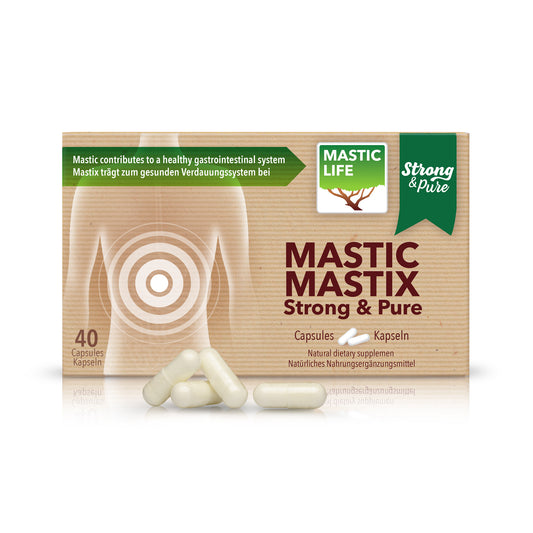Studies: CHIOS MASTIC IN SKIN CARE
In the 19th century, French pharmacopoeias mentioned Chios Mastic gum as a component against skin conditions. Owing to its antimicrobial and adhesive properties Chios Mastic has found its place in many applications which last until our days, including surgical dressings, wound adhesives, medical strips and skin preparations, such as anti-irritation creams.
Study 1
In 1986, Mikhail et al investigated among others the increase in adhesive power by a compound tincture of benzoin (CTB) compared to a preparation containing Chios Mastic (Mastisol, which is an alcohol solution of a mastic compound). It was clearly shown that the latter preparation provided a notably more adhesive strength than that obtained by CTB. 98.
Study 2
Mikhail et al (1989) studied, among others, the same compound (Mastisol) with and without 1/2-inch Steri-Strips (0.5 inch wide), to evaluate certain adhesive methods. With a tension of 2.2 pounds/square inch (1 kg/6.5 cm2), the combination of Mastisol and 0.5 inch Steri-Strips provided the strongest adhesion. The studied application should also be useful, in case other types of surgical dressings must be anchored in place 99.
Study 3
In 1992, Lesesne studied the postoperative use of wound adhesives, and more specifically of Chios Mastic and benzoin, USP. The results, indicate that Chios Mastic not only offers superior adhesive qualities compared with benzoin, USP but it possesses a decreased incidence of postoperative contact dermatitis and subsequent skin discoloration as well. Interestingly, it is important in documenting the reduced appearance of complications and the benefits of Chios Mastic 100.
Study 4
Ali-Shtayeh and Abu Ghdeib (1999) examined Chios Mastic, among an adundance of plant extracts against dermatophytes (Microsporum canis, Trichophyton mentagrophytes and Trichophyton violaceum). Chios Mastic inhibited all three dermatophytes by 90-100% 101.
Study 5
In 2001, a study group investigated the antiphlogistic activity of Chios Mastic essential oil in skin subjected to epilation, by thermolysis or enzymes in different skin region and peeling. Interestingly, creams containing the above mentioned oil caused a notable decrease in the time period needed to alleviate the irritation caused by epilation or peeling, in comparison with skin regions that received placebo cream treatment and which were deprived of the oil 102.
Study 6
Yavuzer et al (2005) studied the burst strength of suture closure versus the use of suture and strip together. Conclusively, strip reinforcement with and/or without Chios Mastic did not provide any supplementary strength in the use of sutures. Furthermore, Chios Mastic augmented the strip adherence, something essential when strips were the only means to close a wound 103.
- Mikhail G.R., Selak L., Salo S. [1986]: Reinforcement of surgical adhesive strips. J Dermatol Surg Oncol., 12 (9): 904-905, 908.
- Mikhail G.R., Selak L., Salo S., Balle M.R. [1989]: The efficacy of adhesives in the application of wound dressings. J Burn Care Rehabil., 10 (3): 216-219.
- Lesesne C.B. [1992]: The postoperative use of wound adhesives. Gum mastic versus benzoin, USP. J Dermatol Surg Oncol., 18 (11): 990.
- Ali-Shtayeh M.S., Abu Ghdeib S.I. [1999]: Antifungal activity of plant extracts against dermatophytes. Mycoses, 42: 665–672.
- Protopapa E.E., Heliou A., Tsigonia A., Kefala V., Triantafyllou A., Tsaknis J. [2001]: The antiphlogistic action of the Chios mastic essential oil: Treatment of skin irritations resulting from hair epilation and peeling with lotions containing mastic essential oil. Epitheorese Klinikes Farmakologias kai Farmakokinetikes, International Edition, 16: 203-205.
- Yavuzer R., Kelly C., Durrani N., Mittal V., Jackson I.T., Remine S. [2005]: Reinforcement of subcuticular continuous suture closure with surgical adhesive strips and gum mastic: Is there any additional strength provided? Am J Surg., 189 (3): 315-318.
Mastic for your gastrointestinal tract
-
Mastic Strong&Pure Economy Pack (240 Capsules) Masticlife
Regular price 32.600 FtRegular priceUnit price / per34.800 FtSale price 32.600 FtSale -
Mastic Strong&Pure (40 Capsules) Masticlife
Regular price 6.300 FtRegular priceUnit price / per -
Mastic Chios Raw Tears Medium Size 10 x 10 g
Regular price 14.000 FtRegular priceUnit price / per -
Mastic+ Prebiotic (160 Capsules) Masticlife
Regular price 17.100 FtRegular priceUnit price / per





